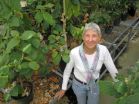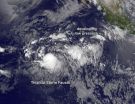(Press-News.org) SALT LAKE CITY, July 9, 2014 – Collectors found the first two specimens of the prickly plant in 1974 and 1990 in west Texas. Then, for two decades, the 14-inch-tall plant was identified wrongly as one species, then another and then a third.
Now – after a long search turned up a "pathetic, wilted" third specimen – a University of Utah botanist and her colleagues identified the spiny plant as a new, possibly endangered species and named it "from the heart" in Latin because it was found in Valentine, Texas, population 134 in 2010.
Most new plant species are found in the tropics, and it is uncommon for a new one – especially a flowering plant – to be found in the United States, says University of Utah biology professor Lynn Bohs, senior author of a new study describing and naming Solanum cordicitum (pronounced So-lay-num core-duh-SEE-tum).
"It's a new, unique plant from the United States," she says. "Plus it's from Valentine, which is extremely charming, and that gave rise to its name, S. cordicitum."
Bohs' study identifying S. cordicitum as a new species was published today in the Aug. 1 issue of the Journal of the Botanical Research Institute of Texas.
The three specimens of S. cordicitum – all now pressed and mounted in museums – are the only ones known to exist. The new species belongs to the genus Solanum, which includes some 1,500 species of mostly poisonous plants, including nightshades, but also three economically important, global food crops: tomatoes, potatoes and eggplants – the last of which is most closely related to S. cordicitum, Bohs says.
Cordicitum is derived from cordicitus, Latin for "from the heart," but is altered to cordicitum because it must end with the same syllable as Solanum to comply with naming rules. The plant has no common name. The derivation of Solanum is unknown, but may be from sol for sun or from solamen for consolation, comforting or quieting.
"Some of them are permanently quieting because they are deadly poisonous," Bohs says. The Solanaceae family, including the genus Solanum, is known as the nightshade family, and many of the plants are toxic, hallucinogenic or medicinal, although others – like tomatoes, potatoes and chili peppers – are edible.
The International Union for the Conservation of Nature's Red List of endangered and threatened species categorizes the status of newly identified S. cordicitum as "data deficient," but Bohs says it "probably is really endangered."
Bohs conducted the research with two other botanists: Stephen R. Stern, who earned his doctorate at the University of Utah and now is on the faculty of Colorado Mesa University in Grand Junction; and Jeffrey Keeling, who just earned his master's degree at Sul Ross State University in Alpine, Texas.
Three Other Plants Elevated from Varieties to Species
Discovery of the new species was a small part of a five-year, $4.36-million National Science Foundation-funded study – led by Bohs – to better classify and create a comprehensive online inventory of all 1,500 species in Solanum, one of Earth's largest genera of flowering plants.
In the same study, the botanists elevate to full species status three other closely related plants that were previously named varieties of other Solanum species but that DNA analysis showed to be separate species. Like the new species, they all belong to a group of Solanum named section Androceras, which now includes 16 species with the reclassifications by Bohs and colleagues:
-- S. knoblochii (no-BLOCK-ee-eye) previously was classified as S. citrullifolium variety knoblochii. Only five plants have been collected from two sites in Mexico's western Chihuahua state. Its status is "data deficient," but Bohs and colleagues write that it "warrants near-threatened status."
-- S. setigeroides (seh-tidge-ger-OID-ees) and S. novomexicanum (novo-Mexi-can-um) both were classified previously as varieties of S. heterodoxum. The first species is a widespread weed from northern Chihuahua and west Texas to central Arizona and New Mexico. The other is found only in northern New Mexico. The Red List categorizes both as species of "least concern," meaning they are neither threatened nor endangered.
Hunting for a Suspected New and Endangered Species
Newly identified S. cordicitum grows only about 14 inches tall. The stems and leaf stalks have very short hairs as well as prickles or spines about one-fifth-inch long, "but that's still long enough to stick you," Bohs says. The leaves have three or four lobes on each side. Prickles also cover the flower clusters, which have five to eight flowers.
"Prickles are all over this sucker," Bohs says.
The first specimen of S. cordicitum was collected in October 1974 on U.S. 166 about 30 miles west of Fort Davis, Texas. Then in September 1990, a Valentine resident named Howard Elder found the plant on his property. A botanist wrongly identified the plant as S. heterodoxum. It later was wrongly re-identified two more times: as S. davisense in 1997 and as a variety of S. grayi in 2006.
But Bohs and colleagues believed it was none of those species because its flower petals are white instead of yellow, and its flower stalks are longer and flowers are larger than closely related species. There also are differences from other species in leaf shape and in stem hairs.
Also, a study published in 2010 by Stern, Bohs and Utah postdoctoral researcher Terri Weese showed the plant's DNA differed from known species. And the plant is an annual, while related species are perennials.
So Bohs and colleagues decided to try to find more specimens. In 2010, Stern – then a Utah grad student – spent days looking for the plant in Texas without success.
In November 2013, Keeling searched the Valentine area for days before finding the third specimen on the Elder property – near where the 1990 specimen was found.
"He looked everywhere and finally found one horrible, wilted plant specimen," Bohs says. "It looked awful. It was wilted and brown and had some seeds we thought we'd be able to germinate, but they weren't any good. It was totally pathetic, and we were sad because we wanted a beautiful picture of the flowers to put in a publication."
"It's probably not extinct because Keeling found one plant that had been living in 2013," she adds. "Whether that was the last one or not, we don't know. We're hoping that by publicizing this, more people will look for it and more plants will be found." Stern believes more are out there.
Keeling collected the specimen of S. cordicitum, pressed and mounted it, then sent it to Stern in Grand Junction. The specimen found in 1974 now is at the University of Texas at El Paso. The 1990 specimen is stored at the University of Texas at Austin.
Weedy but Not a Weed
S. cordicitum and the varieties that are newly elevated to species belong to section Androceras, which is a group of weedy Solanum plants native to the central and southwestern U.S. and Mexico. That is unusual because most Solanum groups are tropical, Bohs says. The most widespread Androceras species is S. rostratum, known as buffalo bur, prickly nightshade and Kansas thistle.
In all Androceras species, the calyx, or outer envelope of the flower and fruit "is really spiny," Bohs says. A larger group of 350 to 400 Solanum species are known as "spiny solanums" because they have prickles. The group includes wild eggplant. Spines have been bred out of domestic eggplant.
While S. cordicitum belongs to a weedy group within the spiny solanums, technically it isn't a weed because weeds are more common and spread easily, Bohs says.
Like other plants in Androceras, the new species and its five-petaled flowers are "bilaterally symmetrical" (like a mirror image down a vertical line) but not symmetrical in all directions because the five petals vary in size. Four of its yellow anthers – pollen organs within the flower – are the same size, but the fifth is bigger.
"It's got a beautiful, interesting flower form unique in Solanum," Bohs says.
INFORMATION:
University of Utah Communications
75 Fort Douglas Boulevard, Salt Lake City, UT 84113
801-581-6773 fax: 801-585-3350
http://www.unews.utah.edu
New plant species from the heart of Texas
Wrongly identified since 1974, only 3 specimens are known
2014-07-09
ELSE PRESS RELEASES FROM THIS DATE:
Minimally invasive surgery underused at many US hospitals
2014-07-09
Hospitals across the country vary substantially in their use of minimally invasive surgery, even when evidence shows that for most patients, minimally invasive surgery is superior to open surgery, a new study shows. The finding represents a major disparity in the surgical care delivered at various hospitals, the study's authors say, and identifies an area of medicine ripe for improvement.
"Some surgeons specialize in complex open operations, and we should endorse that expertise," says Marty Makary, M.D., M.P.H., a professor of surgery at the Johns Hopkins University School ...
Carbon monoxide predicts 'red and dead' future of gas guzzler galaxy
2014-07-09
Astronomers have studied the carbon monoxide in a galaxy over 12 billion light years from Earth and discovered that it's running out of gas, quite literally, and headed for a 'red and dead' future.
The galaxy, known as ALESS65, was observed by the Atacama Large Millimeter Array (ALMA) in 2011 and is one of less than 20 known distant galaxies to contain carbon monoxide.
Dr Minh Huynh from The University of Western Australia node of the International Centre for Radio Astronomy Research (ICRAR) led the team on their search for galactic carbon monoxide in work published ...
Health-care worker hand hygiene rates increase three-fold when auditors visible
2014-07-08
Hand hygiene rates were found to be three times higher when auditors were visible to healthcare workers than when there were no auditors present, according to a study in a major Canadian acute care hospital.
The study, titled, "Quantification of the Hawthorne effect in hand hygiene compliance monitoring using an electronic monitoring system: a retrospective cohort study," published today on-line in the BMJ Quality & Safety Journal, by first author Dr. Jocelyn Srigley, who did the study as part of her Master's thesis while a Clinical Fellow in Infection Prevention and ...
LJI develops new approach to identify genes poised to respond in asthma patients
2014-07-08
SAN DIEGO – July 8, 2014 In a study published yesterday in the scientific journal Nature Immunology, a group at the La Jolla Institute (LJI) led by Pandurangan Vijayanand, Ph.D. identify new genes that likely contribute to asthma, a disease that currently affects over 200 million people world wide.
An organism's genetic material, also known as its genome, can be divided into small sections or 'neighborhoods.' Scientists can determine which genetic neighborhoods in a cell are active, or primed for gene production, by looking for a marker on the genome called an enhancer. ...
Astronomers bring the third dimension to a doomed star's outburst
2014-07-08
VIDEO:
NASA Goddard astrophysicists Ted Gull and Tom Madura discuss Eta Carinae and their new model of the Homunculus Nebula, a shell of gas and dust ejected during the star's mid-19th...
Click here for more information.
In the middle of the 19th century, the massive binary system Eta Carinae underwent an eruption that ejected at least 10 times the sun's mass and made it the second-brightest star in the sky. Now, a team of astronomers has used extensive new observations to create ...
NASA's SDO spots a summer solar flare
2014-07-08
The sun emitted a mid-level solar flare, peaking at 12:20 p.m. EDT on July 8, 2014, and NASA's Solar Dynamics Observatory captured images of the event. Solar flares are powerful bursts of radiation. Harmful radiation from a flare cannot pass through Earth's atmosphere to physically affect humans on the ground, however -- when intense enough -- they can disturb the atmosphere in the layer where GPS and communications signals travel.
To see how this event may affect Earth, please visit NOAA's Space Weather Prediction Center at http://spaceweather.gov, the U.S. government's ...
NASA-JAXA's new precipitation satellite sees first Atlantic hurricane
2014-07-08
VIDEO:
The animation begins with global infrared data showing the progression of the storm as it forms into a hurricane. Then GPM flies overhead measuring rain rates on the ground. GPM's...
Click here for more information.
The Global Precipitation Measurement (GPM) Core Observatory flew over Hurricane Arthur five times between July 1 and July 5, 2014. Arthur is the first tropical cyclone of the 2014 Atlantic hurricane season.
GPM is a joint mission between NASA and the Japan ...
Satellite sees newborn Tropical Storm Fausto being 'chased'
2014-07-08
Tropical Storm Fausto was literally born yesterday and strengthened to a tropical storm quickly. Satellite imagery from NOAA's GOES-West satellite shows a rounded Fausto being "chased" by a developing area of low pressure to the east of the storm.
NOAA's Geostationary Operational Environmental Satellite GOES-West captured a combination visible and infrared image of the Eastern Pacific on July 8 at 1500 UTC (10 a.m. EDT). In the image, Tropical Storm Fausto appeared as a rounded area of clouds, compared to the amorphous developing low pressure area behind it.
At 6:30 ...
NCI study finds extreme obesity may shorten life expectancy up to 14 years
2014-07-08
Adults with extreme obesity have increased risks of dying at a young age from cancer and many other causes including heart disease, stroke, diabetes, and kidney and liver diseases, according to results of an analysis of data pooled from 20 large studies of people from three countries. The study, led by researchers from the National Cancer Institute (NCI), part of the National Institutes of Health, found that people with class III (or extreme) obesity had a dramatic reduction in life expectancy compared with people of normal weight. The findings appeared July 8, 2014, in ...
Virtual reality crowds produce real behavior insights
2014-07-08
VIDEO:
Researchers at Brown University have developed a wireless virtual reality system to better understand how pedestrians interact with one another and generate patterns of crowd movement.
Click here for more information.
PROVIDENCE, R.I. [Brown University] —The cognitive scientists in the Virtual Environment Navigation lab at Brown University are not only advancing a frontier of behavioral research but also of technology.
Led by Professor William Warren, the group developed ...
LAST 30 PRESS RELEASES:
Strategic river sensors could have forewarned of Texas Camp flood disaster
Drone sampling of whale breath reveals first evidence of potentially deadly virus in Arctic
Roman soldiers defending Hadrian’s Wall infected by parasites, study finds
Pinochet’s prisoners were tormented with music but still found solace in it, a new book reveals
Fertility remains high in rural Tanzania despite access to family planning
AI-assisted device can improve autism care access
Kinetic careers
Uncovering how parasitic plants avoid attacking themselves to improve crop resistance
Nanoparticle vaccine strategy could protect against Ebola and other deadly filoviruses
Study finds brain care score can predict risk of stroke across racial groups
Key lung immune cells can intensify allergic reactions
Do hormones explain why women experience more gut pain?
New materials conduct ions in solids as easily as in liquids
Breakthrough of the Year: Renewable energy begins to eclipse fossil fuel-based sources
LLM use is reshaping scientific enterprise by increasing output, reducing quality and more
Introducing LightGen, a chip for ultra-fast, ultra-efficient generative AI
Astronomers see fireworks from violent collisions around nearby star
ACC/AHA issue new guideline on managing congenital heart disease in adults
Cosmic crash caught on camera
Is talented youth nurtured the wrong way? New study shows: top performers develop differently than assumed
Ants: An untapped resource in the development of antibiotics?
Archaeologists use AI to create prehistoric video game
Mitochondria migrate toward the cell membrane in response to high glucose levels
Tiny viral switch offers hope against drug-resistant bacteria
Most parents aware of early peanut introduction guidelines, but confused about details
HPV vaccine can protect against severe lesions of the vulva and vagina
Virtual care provision and emergency department use among children and youth
Quadrivalent HPV vaccine and high-grade vulvovaginal lesions
Insights into dry eyes gained from stem cell-derived tear glands
Researchers identify 166 human pluripotent stem cell lines available for use in clinical applications
[Press-News.org] New plant species from the heart of TexasWrongly identified since 1974, only 3 specimens are known








